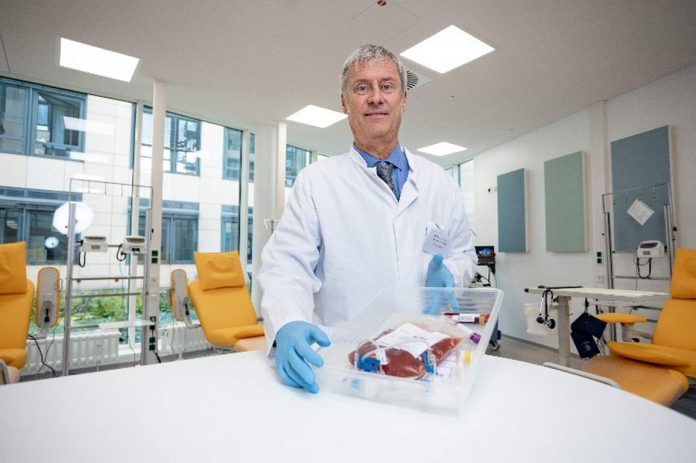
INDIA: For many people with blood cancer worldwide, hope for a cure lies in the cryotanks of the DKMS Stem Cell Bank. The international non-profit organization DKMS is dedicated to providing people with blood cancer a chance at a second life. Since November 2023, the DKMS Stem Cell Bank has been cryopreserving and storing surplus blood stem cells, with the consent of donors, that remain after the initial donation. These cryopreserved stem cells are then made available to patients and transplantation centers worldwide for stem cell transplantation. Just one year after the first stem cells were stored in the cryotank, the first patient successfully received a cryopreserved stem cell donation.
Every 27 seconds, someone in the world is diagnosed with a blood cancer or a blood disorder, and for many people affected a stem cell transplantation is the only hope for a cure. For both initial and repeat transplants, finding a match and getting the stem cells to the patient as quickly as possible is very important as this has a major impact on survival. But even when a match is found, it can take up to 12 weeks before transplantation takes place, making the procedure a race against time. It remains a race against time.
Therefore, it is important to develop additional approaches to stem cell transplantation to speed up the process. This urgent need was the initial motivation to expand the activities for processing and storing cryopreserved stem cells for the DKMS Stem Cell Bank. Experience Studies show that the average stem cell donor produces more stem cells than are needed for a transplant. If the donor meets certain criteria and gives consent, the excess cells collected during apheresis are preserved at very low temperatures. The scientific term for preserving these types of cells is cryopreservation (from the Greek “kryos”, cold). In this state, the cells can be stored in special cryotanks, until they are requested for another person with blood cancer. Once a request is received, it usually takes up to three business days to transport the material – an advantage that saves valuable time in the race against blood cancer.
“This approach is straightforward and one hundred percent ethical for our voluntary donors. We only approach those who donate to a specific person anyway. This way, our donors can save two lives with one donation,” said Dr. Alexander Platz, Medical Director of the DKMS Stem Cell Bank.
First transplantation of stem cells from the cryotank
The first transplantation of such cryopreserved stem cells from the DKMS Stem Cell Bank showed that this is not just theory. The patient received this transplant as a second graft. The stem cells used were cryopreserved and stored at the time of the first transplant. The fact that the cells were already available in the DKMS Stem Cell Bank had many advantages: the confirmatory typing and the preliminary examination had already been carried out, and the donation arrived at the transplantation center within a few days. This allowed the patient to receive the stem cells he needed as soon as possible. At the same time, the donor did not have to make any additional effort, since a second donation was not necessary. A second donation is not a single case. Generally, about one in 30 donors donates stem cells for a second time, mostly for the same patient. Since the stem cells have been stored in the DKMS Stem Cell Bank, this will not always be necessary in the future – two stem cell grafts were obtained from one collection, and both have now been used.
The first transplantation of cryopreserved stem cells from the DKMS Stem Cell Bank proves that this approach is more than just a theory. The patient received the transplant as a second graft, using stem cells that had been cryopreserved and stored at the time of the initial transplant. Having these stem cells readily available in the DKMS Stem Cell Bank offered several advantages: confirmatory typing and preliminary examinations had already been completed, and the donation reached the transplantation center within a few days. This enabled the patient to receive the necessary stem cells as quickly as possible without requiring the donor to undergo another procedure, as a second donation was unnecessary.
Second donations are not uncommon; approximately one in 30 donors donates stem cells a second time, usually for the same patient. However, with stem cells now stored in the DKMS Stem Cell Bank, such additional donations may no longer be required in many cases. From a single collection, two stem cell grafts were obtained and have both been successfully used.
“The whole team in Dresden was very happy about this first stem cell transplantation from the DKMS Stem Cell Bank. The delivery process from the cryotank to the patient and the transplantation went smoothly, but now we have to keep our fingers crossed. We truly hope that the treatment will now have the desired effect,” said Dr. Alexander Platz.
The DKMS Life Science Lab, the Clinical Trials Unit, the DKMS Collection Center, and the Collaborative Biobankare further facilities that contribute to research and development in the field of stem cell donation in the science hub of Dresden, Germany.
In this case, the DKMS does not disclose any further information in order to maintain anonymity. Patients should be given the opportunity to fully concentrate on themselves and their recovery during this physically and mentally difficult time. Only after a two-year period and with the consent of both parties can anonymity be rescinded.
